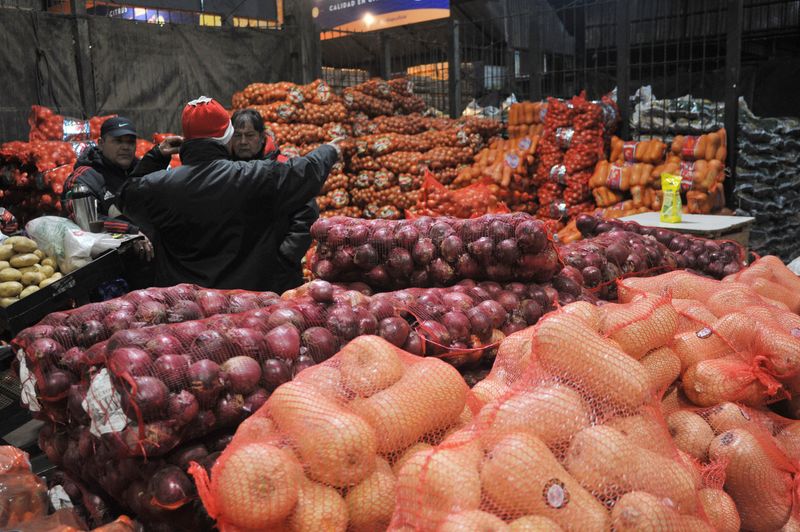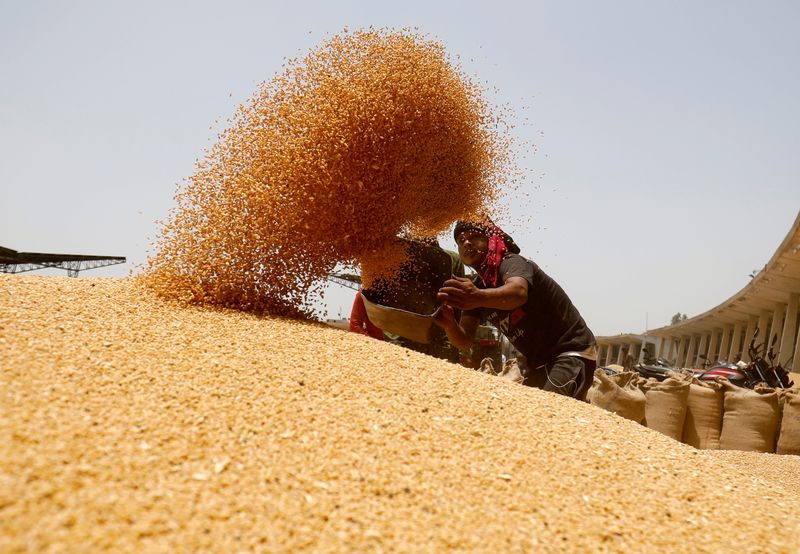By Rajendra Jadhav, Maximilian Heath and Nigel Hunt
MUMBAI/BUENOS AIRES/LONDON (Reuters) - It only took 24 hours last month for Prime Minister Narendra Modi's government in India - the world's second-largest producer of wheat - to shelve its plans to "feed the world".
In April, Modi had said publicly that the world's most populous democracy was ready to fill part of the gap left by Ukraine in global grains markets by increasing its wheat exports, following five consecutive record harvests. India traditionally exports only a modest amount of wheat, retaining most of its crop for domestic consumption.
On May 12, India's Ministry of Commerce & Industry said it was preparing to send delegations to nine countries to export a record 10 million tonnes of wheat this fiscal year - sharply up the previous season.
But a barrage of alarming data changed all that.
First came a downward revision to India's wheat crop in early May as a sudden heatwave hammered yields. Then data on May 12 showed inflation in the nation of 1.4 billion had jumped to a near eight-year high due to higher food and fuel prices, driven by the Ukraine war.
Alarmed by rising inflation, which had contributed to toppling the previous Congress party government in 2014, Modi's office told the Ministry of Commerce on May 13 to put the "brakes on" wheat exports immediately, according to one government official, who asked not to be identified because of the sensitivity of the issue.
"This (inflation data) prompted the government to issue an order at midnight" imposing a ban on wheat exports, said a second source.
News of the ban by India, which is the only major wheat exporter at that time of year, drove Chicago wheat futures 6% higher after markets reopened on Monday.
Neither Modi's office nor the Ministry of Commerce responded to a request for comment.
India is one of at least 19 countries that have introduced food export restrictions since the war in Ukraine sent prices soaring, hampering international trade flows for several agricultural products and sparking violent protests in some developing nations.
(For an interactive graphic, click here: https://tmsnrt.rs/3wZqRBV)
From Delhi to Kuala Lumpur, Buenos Aires to Belgrade, governments imposed restrictions, at a time when the economic damage caused by the COVID-19 pandemic, combined with factors such as extreme weather and supply chain bottlenecks, had already driven hunger across the globe to unprecedented levels.
The U.N. World Food Programme (WFP) said in April the number of people facing acute food insecurity - when their inability to consume adequate food puts their lives or livelihoods in danger - had already more than doubled since 2019 to 276 million in the 81 countries in which it operates, before the Ukraine conflict began.
The war - which disrupted exports from Russia and Ukraine, two agricultural powerhouses - was forecast to increase that number by at least 33 million, mostly in sub-Saharan Africa, it forecast.
Under World Trade Organization rules, members can impose export prohibitions or restrictions of foodstuffs or other products if they are temporary and required to relieve "critical shortages".
India's Commerce Minister Piyush Goyal told Reuters last month he had been in contact with the WTO and the International Monetary Fund (IMF) to explain that India needed to prioritise its own food security, stabilize domestic prices and protect against hoarding.
But export restrictions risk worsening the rise in global food prices: producing a domino effect as a deepening crisis prompts other countries to take similar steps, said Michele Ruta, the lead economist in the Macroeconomics, Trade & Investment Global Practice of the World Bank Group.
Many economists say the global food crisis is already more severe than the last one that peaked in 2008, which was driven by factors including droughts, global population growth, higher consumption of meat in major developing economies, and the increased use of crops to produce biofuels.
Shortages at that time triggered protests across the globe, particularly in Africa where food represents a comparatively high proportion of household budgets.
Simon Evenett, professor of international trade and economic development at the University of St. Gallen, said the assurances in 2008 from international organizations to national governments that there was enough food to go around globally took some of the wind out of the sails of those pushing for export curbs.
"This time around that is harder to do as we do have a supply hit here in both Ukraine and Russia," Evenett said, adding the size of summer harvests in major food producers would help determine how things develop in the second half of 2022.
Ukraine and Russia accounted for a combined 28% of global wheat exports, 15% of corn and 75% of sunflower oil in the 2020/21 season, according to U.S. Department of Agriculture data.
World food prices have stabilized at high levels in the past two months as harvests approach. However, there are already some worrying signs with drought in the United States set to reduce the size of the winter wheat crop while in France wheat crops were battered by hail, strong winds and torrential rains this month.
Dry weather in Argentina - the world’s sixth largest wheat exporter - has stalled planting of the crop and weighed down production forecasts for the 2022/23 season.
Moreover, the mood in the international forum's such as G20 is now less collaborative after years of populism and heightened tension between major geopolitical players, Evenett said.
"This current situation in many ways is a lot more troubling than 2008 and look at what risks arose then to political stability," he said. "We will have a very tense six to nine months ahead of us."
FALLING DOMINOS
Some countries had already announced export curbs last year, given the tightness in global food supplies. But the dominos really started to fall following Russia's invasion of Ukraine on Feb. 24, with global prices of both grains and vegetable oils soaring.
In March, Argentina increased taxes on its soybean oil and meal exports and has imposed a lower cap than last year for new wheat exports.
India's ban on wheat exports came after Indonesia, the world's top palm oil producer, had already restricted exports of palm oil – an essential ingredient in cooking and baking - from April 28 citing the need to ensure the country had “abundant and affordable supplies.”
India is the world’s biggest importer of palm oil and Indonesia is one of its most important suppliers. Indonesia lifted its ban on May 20.
Malaysia prohibited on May 23 the export of chickens from the beginning of this month after a global feed shortage exacerbated by the conflict in Ukraine disrupted poultry production and led to a sharp rise in prices for one of the country’s cheapest sources of protein.
The wave of export restrictions already affect nearly one-fifth of calories traded globally – that's nearly double the impact of the last global food crisis of 2008, according to the International Food Policy Research Institute (IFPRI), a Washington-based think tank that aims to reduce poverty in developing countries.
"These types of measures tend to provoke some panicked behavior or hoarding from the buyers side...that accelerates the price spike," said IFPRI researcher David Laborde Debucquet.
The European Union - which includes several of the world’s biggest food importers by value - is urging its trade partners not to enact protectionist policies.
"The European Union keeps its food exports going, and so should everyone else," EU Commission President Ursula von der Leyen said in a speech this month.
ENSURING DOMESTIC SUPPLIES
Even before the war in Ukraine, Argentina's government, battling domestic inflation now over 60%, took steps late last year to stem the rise in local food prices. It placed caps on exports of corn and wheat, adding to an earlier ban on shipments of beef.
After Russia’s invasion, it took additional steps, raising the taxes on shipments of processed soy oil and meal.
Argentina is the world’s biggest soybean oil and meal exporter, the second-largest global provider of corn and a key wheat exporter.
A source in Argentina's Agriculture Ministry, who asked not to be identified because he was not authorized to speak to the media, said the government's priority was to safeguard foodstuffs needed for domestic consumption.
The export limits established in late 2021 helped to shield domestic millers and consumers from the spike in international prices following the conflict in Ukraine, the source said.
But Gustavo Idigoras, head of Argentina's CIARA-CEC chamber of grains processors and exporters, said that despite the export caps and additional taxes, the government had struggled to stem entrenched food price inflation in Argentina, which was already high before the Ukraine conflict.
In the Buenos Aires metropolitan area, the cost of bread has risen 69% in a year, meat 64% and vegetables 66%, forcing people to change their diets and seek cheaper deals.

Edith Elizabeth Plou, 39, a shopkeeper in Buenos Aires, had traveled miles from her home to come to the Argentine capital's large Central Market to get cheaper prices for her groceries, which have spiked sharply over the last year.
"I work eight hours and the truth is that I often think about finding a second job to cover my expenses,” Plou said.
